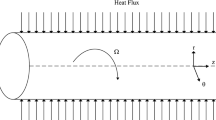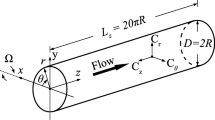Abstract
The numerical simulations of the dynamics of high Reynolds number (\(Re>100{,}000\)) swirling flows in pipes with varying geometries of engineering applications continues to be a challenging computational problem, specifically when vortex-breakdown zones or wall-separation regions naturally evolve in the flows. To tackle this challenge, the present paper describes a simulation scheme of the evolution of inviscid, axisymmetric and incompressible swirling flows in expanding or contracting pipes. The integration in time of the circulation together with azimuthal vorticity uses an explicit, first-order accurate finite-difference scheme with a second-order accurate upwind difference formulation in the axial and radial directions. The Poisson solver for advancing in time the spatial distribution of the stream function as a function of azimuthal vorticity uses a second-order accurate over-relaxation difference scheme. No additional numerical steps are needed for computing the natural evolution of flows including the dynamics to states with slow-speed recirculation zones along the pipe centerline or attached to pipe wall. This numerical method shows convergence of the computed results with mesh refinement for various swirl levels and pipe geometry variations. The computed results of time-asymptotic states also present agreement with available theoretical predictions of steady vortex flows in diverging or contracting pipes. In addition, comparison with available experimental data demonstrates that the present algorithm accurately predicts instability processes and long-term mean-flow dynamics of vortex flows in pipes at high Re. The inviscid-flow simulation results support the theoretical predictions and clarify the nature of high-Re flow evolution.













Similar content being viewed by others
References
Erickson GE, Hall RM, Banks DW, Del Frate JH, Schreiner JA (1989) Experimental investigation of the F/A-18 vortex flows at subsonic through transonic speeds. In: 7th applied aerodynamics conference, p 2222
Paschereit CO, Gutmark E (2002) Proportional control of combustion instabilities in a simulated gas-turbine combustor. J Propuls Power 18(6):1298–1304
Peckham DH, Atkinson SA (1957) Preliminary results of low speed wind tunnel tests on a Gothic wing of aspect ratio 1.0. Royal Aircraft Establishment, Farnborough
Lambourne NC, Bryer DW (1962) The bursting of leading-edge vortices some observations and discussion of the phenomenon. Aeronaut Res Counc 3282:1–36
Sarpkaya T (1971) On stationary and travelling vortex breakdowns. J Fluid Mech 45(3):545–559
Sarpkaya T (1974) Effect of the adverse pressure gradient on vortex breakdown. AIAA J 12(5):602–607
Hall MG (1972) Vortex breakdown. Annu Rev Fluid Mech 4(1):195–218
Leibovich S (1984) Vortex stability and breakdown-survey and extension. AIAA J 22(9):1192–1206
Escudier M (1988) Vortex breakdown: observations and explanations. Prog Aerosp Sci 25(2):189–229
Delery JM (1994) Aspects of vortex breakdown. Prog Aerosp Sci 30(1):1–59
Althaus W, Bruecker C, Weimer M (1995) Breakdown of slender vortices. In: Green SI (ed) Fluid vortices. Springer, Berlin, pp 373–426
Sarpkaya T (1995) Turbulent vortex breakdown. Phys Fluids 7(10):2301–2303
Mitchell AM, Delery J (2001) Research into vortex breakdown control. Prog Aerosp Sci 37(4):385–418
Rusak Z (2000) Review of recent studies on the axisymmetric vortex breakdown phenomenon. In: Fluids 2000 conference and exhibit, AIAA paper 2529
Novak F, Sarpkaya T (2000) Turbulent vortex breakdown at high Reynolds numbers. AIAA J 38(5):825–834
Dennis DJC, Seraudie C, Poole RJ (2014) Controlling vortex breakdown in swirling pipe flows: experiments and simulations. Phys Fluids 26(5):053602
Grabowski WJ, Berger SA (1976) Solutions of the Navier–Stokes equations for vortex breakdown. J Fluid Mech 75(3):525–544
Spall RE, Gatski TB, Grosch CE (1987) A criterion for vortex breakdown. Phys Fluids 30(11):3434–3440
Darmofal DL (1996) Comparisons of experimental and numerical results for axisymmetric vortex breakdown in pipes. Comput Fluids 25(4):353–371
Faler JH, Leibovich S (1977) Disrupted states of vortex flow and vortex breakdown. Phys Fluids 20(9):1385–1400
Beran PS, Culick FEC (1992) The role of non-uniqueness in the development of vortex breakdown in tubes. J Fluid Mech 242:491–527
Lopez JM (1994) On the bifurcation structure of axisymmetric vortex breakdown in a constricted pipe. Phys Fluids 6(11):3683–3693
Beran PS (1994) The time-asymptotic behavior of vortex breakdown in tubes. Comput Fluids 23(7):913–937
Wang S, Rusak Z (1996) On the stability of an axisymmetric rotating flow in a pipe. Phys Fluids 8(4):1007–1016
Wang S, Rusak Z (1997) The dynamics of a swirling flow in a pipe and transition to axisymmetric vortex breakdown. J Fluid Mech 340:177–223
Wang S, Rusak Z (1997) The effect of slight viscosity on a near-critical swirling flow in a pipe. Phys Fluids 9(7):1914–1927
Malkiel E, Cohen J, Rusak Z, Wang S (1996) Axisymmetric vortex breakdown in a pipe-theoretical and experimental studies. 36th Israel annual conference on aerospace sciences, Tel Aviv and Haifa, Israel, pp 24–34
Mattner TW, Joubert PN, Chong MS (2002) Vortical flow. Part 1. Flow through a constant-diameter pipe. J Fluid Mech 463:259–291
Rusak Z, Lamb D (1999) Prediction of vortex breakdown in leading-edge vortices above slender delta wings. J Aircraft 36(4):659–667
Snyder DO, Spall RE (2000) Numerical simulation of bubble-type vortex breakdown within a tube-and-vane apparatus. Phys Fluids 12(3):603–608
Vyazmina E, Nichols JW, Chomaz JM, Schmid PJ (2009) The bifurcation structure of viscous steady axisymmetric vortex breakdown with open lateral boundaries. Phys Fluids 21(7):074107
Rusak Z, Granata J, Wang S (2015) An active feedback flow control theory of the axisymmetric vortex breakdown process. J Fluid Mech 774:488–528
Vanierschot M (2017) On the dynamics of the transition to vortex breakdown in axisymmetric inviscid swirling flows. Eur J Mech B 65:65–69
Gallaire F, Chomaz JM (2003) Mode selection in swirling jet experiments: a linear stability analysis. J Fluid Mech 494:223–253
Ruith MR, Chen P, Meiburg E, Maxworthy T (2003) Three-dimensional vortex breakdown in swirling jets and wakes: direct numerical simulation. J Fluid Mech 486:331–378
Qadri UA, Mistry D, Juniper MP (2013) Structural sensitivity of spiral vortex breakdown. J Fluid Mech 720:558–581
Meliga P, Gallaire F, Chomaz JM (2012) A weakly nonlinear mechanism for mode selection in swirling jets. J Fluid Mech 699:216–262
Tammisola O, Juniper MP (2016) Coherent structures in a swirl injector at Re = 4800 by nonlinear simulations and linear global modes. J Fluid Mech 792:620–657
Feng C, Liu F, Rusak Z, Wang S (2018) Dynamics of a perturbed solid-body rotation flow in a finite-length straight rotating pipe. J Fluid Mech 846:1114–1152
Meliga P, Gallaire F (2011) Control of axisymmetric vortex breakdown in a constricted pipe: nonlinear steady states and weakly nonlinear asymptotic expansions. Phys Fluids 23(8):084102
Sahu KC, Govindarajan R (2005) Stability of flow through a slowly diverging pipe. J Fluid Mech 531:325–334
Sahu KC, Sameen A, Govindarajan R (2008) The relative roles of divergence and velocity slip in the stability of plane channel flow. Eur Phys J Appl Phys 44(1):101–107
Jotkar MR, Swaminathan G, Sahu KC, Govindarajan R (2016) Global linear instability of flow through a converging-diverging channel. J Fluids Eng 138(3):031301
Lebon B, Peixinho J, Ishizaka S, Tasaka Y (2018) Subcritical transition to turbulence in a sudden circular pipe expansion. J Fluid Mech 849:340–354
Lebon B, Nguyen MQ, Peixinho J, Shadloo MS, Hadjadj A (2018) A new mechanism for periodic bursting of the recirculation region in the flow through a sudden expansion in a circular pipe. Phys Fluids 30(3):031701
Rusak Z, Zhang Y, Lee H, Wang S (2017) Swirling flow states in finite-length diverging or contracting circular pipes. J Fluid Mech 819:678–712
Garg AK, Leibovich S (1979) Spectral characteristics of vortex breakdown flowfields. Phys Fluids 22(11):2053–2064
Umeh COU, Rusak Z, Gutmark E, Villalva R, Cha DJ (2010) Experimental and computational study of nonreacting vortex breakdown in a swirl-stabilized combustor. AIAA J 48(11):2576–2585
Liang H, Maxworthy T (2005) An experimental investigation of swirling jets. J Fluid Mech 525:115–159
Gallaire F, Chomaz JM (2004) The role of boundary conditions in a simple model of incipient vortex breakdown. Phys Fluids 16(2):274–286
Buntine JD, Saffman PG (1995) Inviscid swirling flows and vortex breakdown. Proc R Soc Lond A 449:139–153
Leclaire B, Sipp D (2010) A sensitivity study of vortex breakdown onset to upstream boundary conditions. J Fluid Mech 645:81–119
Rusak Z, Wang S, Xu L, Taylor S (2012) On the global nonlinear stability of a near-critical swirling flow in a long finite-length pipe and the path to vortex breakdown. J Fluid Mech 712:295–326
Wang S, Rusak Z (2011) Energy transfer mechanism of the instability of an axisymmetric swirling flow in a finite-length pipe. J Fluid Mech 679:505–543
Benjamin TB (1962) Theory of the vortex breakdown phenomenon. J Fluid Mech 14(4):593–629
Squire HB (1956) Chapter on rotating fluids. In: Batchelor GK, Davies M (eds) Surveys in mechanics GI Taylor anniversary volume National Bureau of Standards. Applied Mathematics Series. Cambridge University Press, Cambridge, p 55
Long RR (1953) Steady motion around a symmetrical obstacle moving along the axis of a rotating liquid. J Meteorol 10(3):197–203
Batchelor GK (1967) An introduction to fluid dynamics. Cambridge University Press, Cambridge
Author information
Authors and Affiliations
Corresponding author
Additional information
Publisher's Note
Springer Nature remains neutral with regard to jurisdictional claims in published maps and institutional affiliations.
Rights and permissions
About this article
Cite this article
Zhang, Y., Rusak, Z. & Wang, S. Simulations of axisymmetric, inviscid swirling flows in circular pipes with various geometries. J Eng Math 119, 69–91 (2019). https://doi.org/10.1007/s10665-019-10019-5
Received:
Accepted:
Published:
Issue Date:
DOI: https://doi.org/10.1007/s10665-019-10019-5




